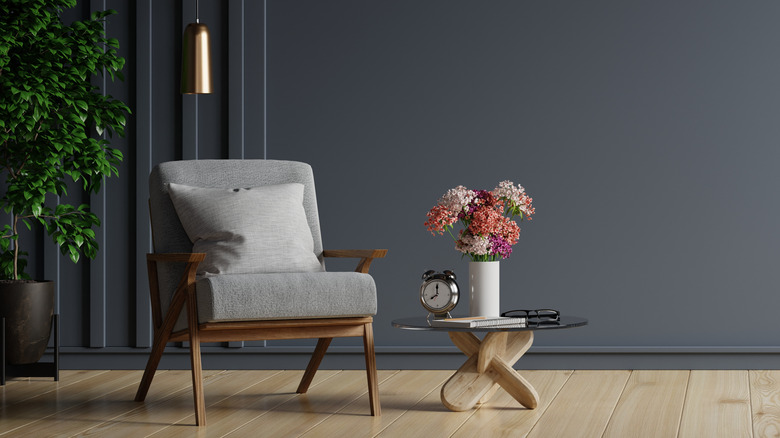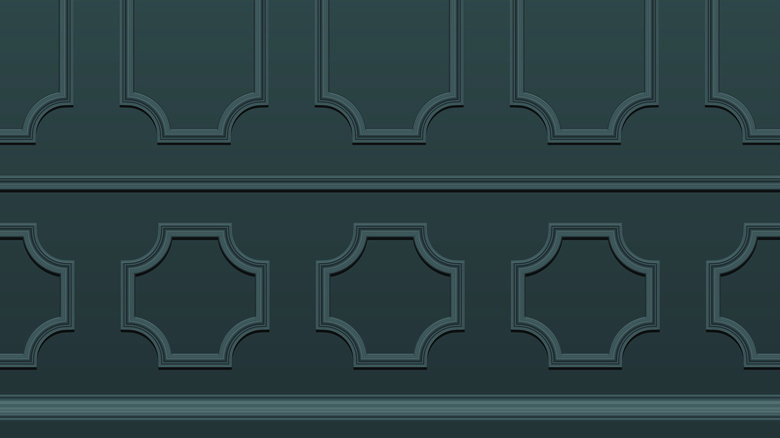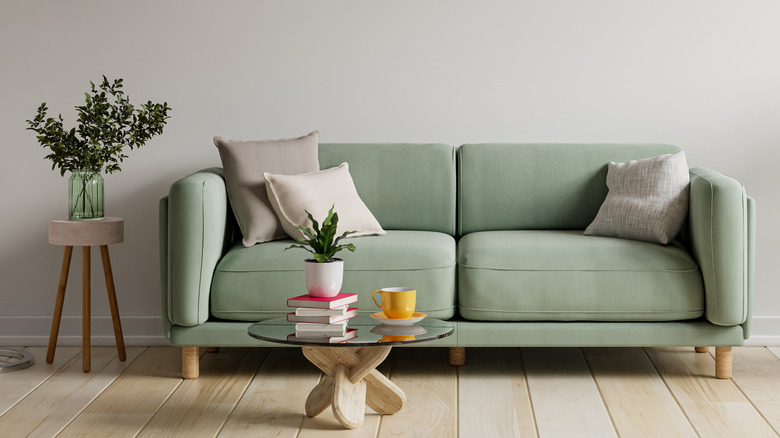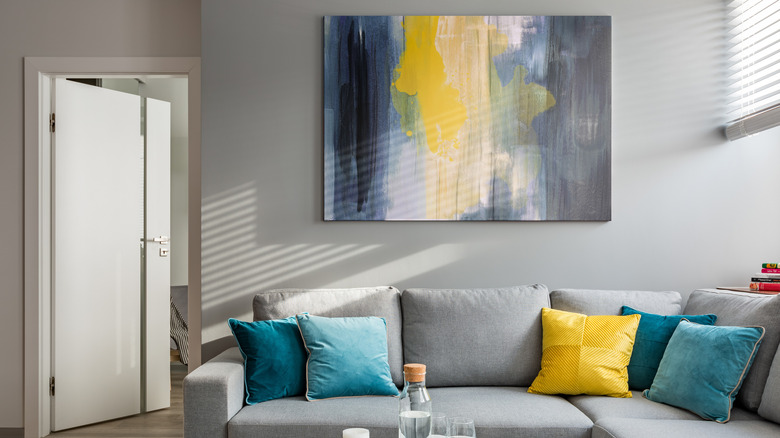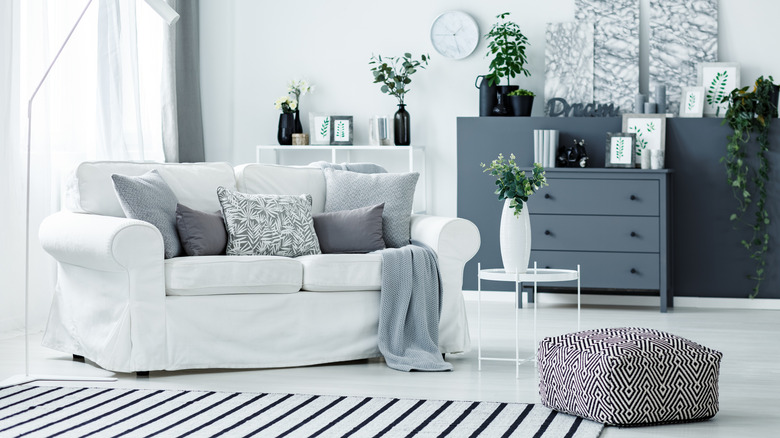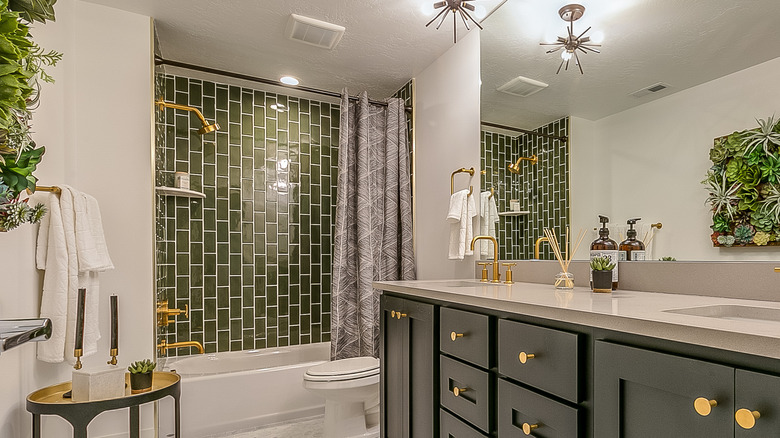5 Simple Pointers For Adding Color To Your Minimalist Spaces
Minimalism has taken many forms throughout the history of interior design. In previous years, minimalism manifested itself through all-white kitchens and sleek black and white interiors. And while this neutral design style isn't going anywhere, it certainly is transforming with the trends. Minimalism in interior design means embracing uncluttered spaces and using the bare essentials to create simple space, says Tarkett. But that doesn't mean a minimalist space is boring.
Minimalism also doesn't always mean decorating in neutrals. While neutral colors are a cornerstone of the design style, there aren't any rules that say you can't add color to a minimalist space. You simply need to approach color a bit more strategically. So if you love the clean and unfussy designs that minimalism is known for, but want to add color for some visual interest, go right ahead. When done well, a few pops of color can look incredible in a neutral space.
Highlight wall features
Of course, a fresh coat of paint is one of the best ways to add color. But why not take it a step further by making the color look intentional? Instead of painting a flat wall, use the paint to highlight the wall features in your home. Wall features like wainscotting and beadboard add some visual interest to a space without overwhelming it with too many details.
These wall features are also easy to paint to match your overall home decor. Maison de Pax suggests using a paint and primer in one to help cover any previous wood stains or paints. And a heavy-duty primer can help cover up stubborn areas of gloss finishes. Other wall features you can highlight with a shade of paint include beadboard and built-in bookshelves.
When it comes to choosing a color for a minimalist space, pastels are a great option because they're light enough to add a subtle color. But if you want to go bolder, blues and greens are often considered neutral-adjacent in that they will add color but not overwhelm the space. You can also choose hues that are more muted so the colors are not as bright.
Statement furniture
Add a pop of color to your space with a statement piece of furniture. One bright item won't overwhelm a room but rather provide a unique feature that can act as a centerpiece. Colorful furniture can also add a bit of personality to the space. For a larger statement, you can choose a colorful sofa, while a smaller statement can be made with accent chairs. The trick to adding colorful furniture in a minimalist room is to choose a sofa design that features clean lines and isn't too fussy. Look for furniture with exposed legs, square shapes, or little ornamentation.
Blues and greens are easy colors to incorporate into most interior designs. But if you're looking for a bolder choice, sunny yellows and golden oranges are brighter options that are also on trend for sofas, says Interiors Online. Metallic finishes are also an interesting way to add color and a touch of glamor to your space. A colorful headboard in the bedroom or chairs in a dining room are more ideas for adding color throughout the home.
Bold art
If you prefer to have your walls and furniture in neutral shades, you still have options to add color to your space. Art can be a great option to add personality to a space. And when the room is mostly neutral, you can feel confident about choosing bolder and more colorful pieces to contrast the rest of the home decor. Using oversized art creates a focal point that creates an impact in the room.
If you're hanging wall art over a sofa, bed, or fireplace, choose a piece that's two-thirds or three-fourths of the width of the furniture, says Elephant Stock. You may also want to consider whether you want to use one large piece of art or multiple smaller panels that come together to create a large piece of artwork. Choose from paintings, canvases, prints, or photographs, depending on your personal style and the style of the room. Be sure to incorporate shapes and colors for visually interesting designs.
Colorful textures
You can make your space feel cozy by adding textures throughout the space. These textures are also a great opportunity to incorporate subtle colors into minimalist designs. According to LuxDeco, texture creates accents in the room by adding visual weight. Textures that add some warmth to a room include blankets, pillows, and rugs. But that's not where adding textures stops; woven screens, plaster designs, and even furniture itself can add texture to a room.
Rugs are a great option to add a subtle pop of color because they can have mostly neutral shades as part of their design. Ballard Designs suggests choosing a living room rug that is at least the length and width of the area where a cluster of furniture sits. A similar size guideline for the dining room is ideal as a rug should be large enough that chairs still sit on it even when pulled out from a table. Throw pillows and blankets are other good options for adding color to minimalist designs. Since they're easily removable and replaceable, you can swap the pieces out by season or when you want to try a new color scheme.
Use tiles
For a more permanent addition of color, you can use tile throughout your home. This will, of course, mean more commitment within a minimalist setting. But tiles also offer a stylish and stunning addition to any room. Emser Tile reports that green and blue are two popular color options. Green is organic and is ideal for homes that want to bring a natural element into the space. Blue is timeless while also providing a sense of calmness to a room. Yellow, red, and pink are also currently trending colors for tiles.
In the kitchen, use tiles on the backsplash behind the counter. For an eye-catching look, extend the tile to the ceiling wherever you can. Shower surrounds and walls in the bathroom can look stunning when covered in colorful tile. But walls aren't the only option for bold tiling. Floor tiles in the kitchen, bathroom, or entryway also add a fun pop to any home.
